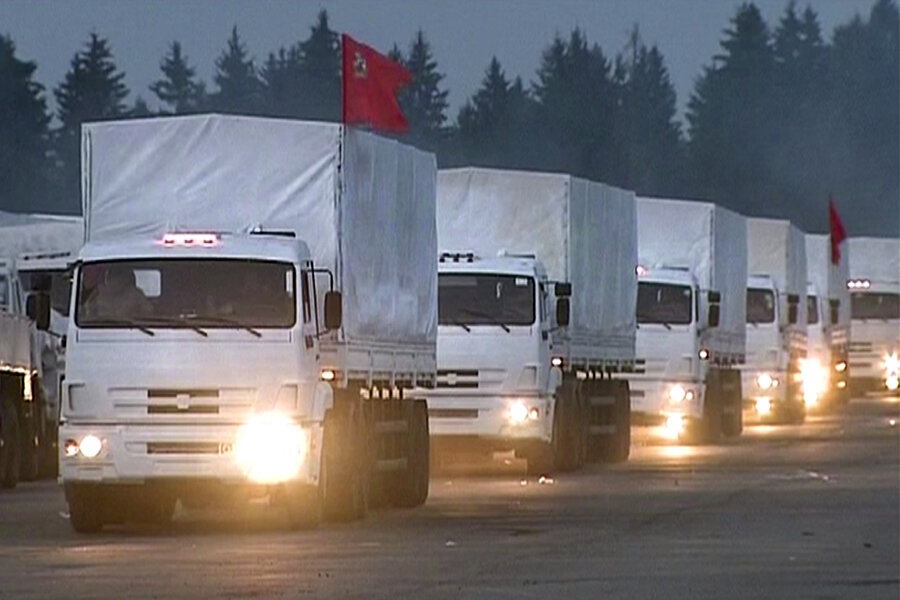Suspicions greet Russian convoy on humanitarian mission to eastern Ukraine
Loading...
A daily roundup of terrorism and security issues
One day after an agreement was struck on an international relief effort in war-torn eastern Ukraine, fears are rising that Russia could use aid as a cover for military intervention.
Today a fleet of 280 Russian trucks carrying 2,000 tons of supplies – including baby food and sleeping bags – was headed toward the Ukrainian border, according to Russian media. However, the International Committee of the Red Cross (ICRC), which is spearheading a separate aid mission, said it was not aware of where the trucks were headed or what they were carrying.
“This convoy is not a certified convoy,” Andriy Lysenko, a spokesman for Ukraine’s National Security and Defense Council, told the Associated Press, referring to the fleet of Russian trucks. “It is not certified by the [ICRC],” and will not be allowed to cross the border.
The ICRC is coordinating an aid mission on behalf of the United States, the European Union, Ukraine, and Russia. A spokesman for the Red Cross mission in Ukraine said: “At this stage we have no agreement on this, and it looks like the initiative of the Russian Federation."
Ukrainian officials say Russia has placed some 45,000 troops along the border with eastern Ukraine, where fighting between pro-Russian separatists and Ukrainian government forces have claimed more than 1,100 lives since April. NATO reports a smaller number of Russian troops on the border with approximately 20,000. NATO said there was a “high probability” that Russia could turn to military intervention in eastern Ukraine, Reuters reports.
Ukraine and the West accuse Russia of arming and training the rebels, a claim Moscow denies. On Monday, EU President José Manuel Barroso warned Russia “against any unilateral military actions in Ukraine, under any pretext, including humanitarian,” according to an EU statement.
Western powers have warned Russia “against mounting a stealth invasion under the guise of humanitarian aid, and have looked on with growing alarm as Russian officials have spoken in ever-stronger terms about the humanitarian plight of eastern Ukrainians,” reports The New York Times.
“We see the Russians developing the narrative and the pretext for such an operation under the guise of a humanitarian operation, and we see a military buildup that could be used to conduct such illegal military operations in Ukraine,” the NATO secretary general, Anders Fogh Rasmussen, told Reuters in an interview Monday.
A Russian intervention would almost certainly provoke another round of economic sanctions by the West, further isolate the Kremlin diplomatically and strain already icy relations with Washington nearly to the breaking point. Apparently calculating that Moscow is unwilling to shoulder those costs, Ukraine has been pressing ahead with its military offensive despite the Russian military buildup.
There’s no denying the need for humanitarian assistance in eastern Ukraine: Nearly a million people have been displaced in the Donetsk and Luhansk regions, and those who stayed in the homes mostly lack electricity and water. The number of refugees crossing the border into Russia has been estimated at close to half a million, straining local services and facilities there, The Christian Science Monitor reports.
Violence continues as Ukrainian troops continue their offensive, cutting off supply lines and shelling outlying districts. On Monday stray rockets hit the gate at a high security prison; more than 100 convicts escaped, according to The New York Times.
In an opinion column for The Boston Globe, Gary Samore and Simon Saradzhyan, directors at Harvard University's Belfer Center for Science and International Affairs encouraged the international community not to "corner" Russian President Vladmir Putin, and to work together to establish a non-military end to the Ukrainian conflict.
Leaders in Kiev, Moscow, and Western capitals need to understand the costs of trying to solve the conflict with force and the benefits of finding a negotiated solution. Such a solution could incorporate elements of Ukrainian leader Petro Poroshenko’s own peace plan, such as amnesty for the rebels, decentralization of power within Ukraine and robust protection of rights of minorities, along with disarming of all the illegal armed formations, a legally binding affirmation of Ukraine’s military neutrality, and unequivocal guarantees (rather than assurances) of Ukraine’s territorial integrity, perhaps, while deferring final resolution of Crimea’s status.
The United States and the European Union should encourage Poroshenko to revive his peace plan. Russia should also press the separatists to negotiate in good faith and aim for realistic goals, such as reintegration into a decentralized Ukraine.
The goal of these collective efforts shouldn’t be total victory for any military alliance, nation, region, or leader. Instead, what eventually emerges ought to be a Ukraine at peace with itself and its neighbors, outside of any military pact, and capable of sustaining itself economically.
.








